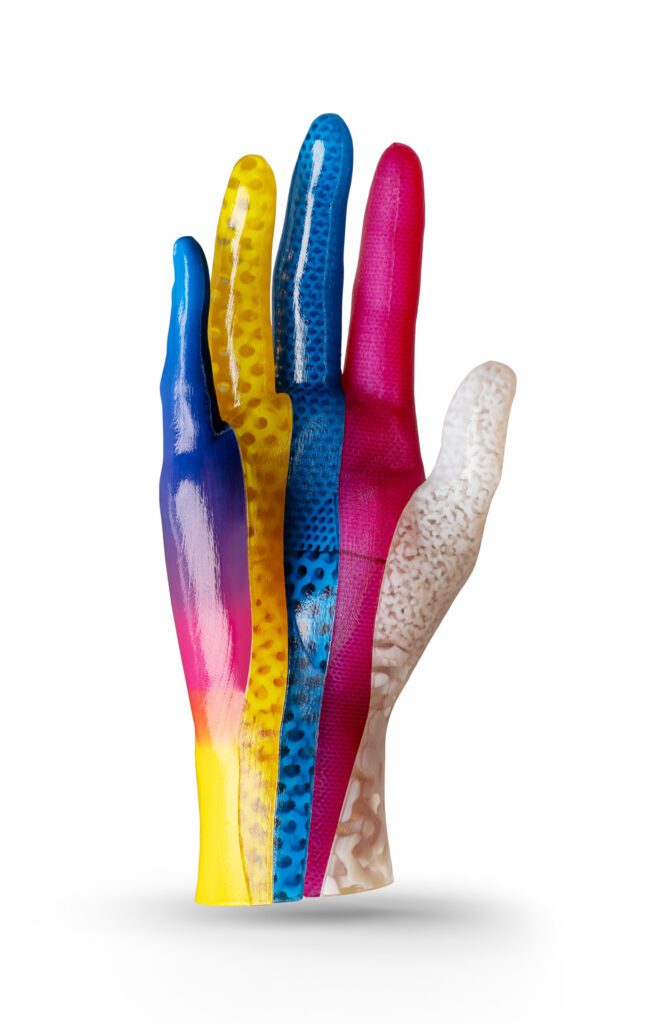3D-printing solutions for the medical industry
Stratasys 3D printing in medical
3D printing in medical industry
By empowering innovation in healthcare, 3D printing in medicine is quite literally changing lives.
3D Printing in medicine allows the design and creation of medical devices tailored to specific needs with breakthrough medical innovations and the creation of new devices that were previously impossible to manufacture.
Medical pioneers have turned to additive manufacturing to create personalised solutions such as patient-specific anatomical models and surgical guides, allowing doctors to perform more effective medical procedures and deliver improved patient outcomes.
Stratasys technology offers a range of material properties – including biocompatible options – to produce true-to-life medical device prototypes. For stronger tooling, custom fixtures and research aids, the high-performance thermoplastics available are incredibly effective.
Medical 3D printing is helping to ensure a better quality of life for people all around the world.
Why use 3D printing in the medical industry?
- Validate device performance on patient-derived 3D-printed anatomical models
- Based on real patient imaging, mimic a variety of tissue and bone properties in a single print
- Accelerate product development from accurate 3D-printed concept models to pre-clinical testing, at a fraction of the cost
From manufacturing to prototyping to education
The 3D printing applications in medicine are vast and growing by the day. In particular, medical 3D printing can play a critical role in the development of personalised treatments for patients.
Custom prosthetics & implants
Advances in 3D printing technology have enabled scientists to develop custom devices that are tailored to a patient’s unique anatomical structure. For example, a surgeon may use 3D printing in surgery or pre-surgery to create a customised prosthetic hand for a patient with a rare condition that prevents them from using their fingers.
These devices can be used to restore the function of damaged body parts or to help surgeons perform complex surgical procedures.
Surgical modelling & planning
Surgical planning is the process of creating a three-dimensional virtual model of a patient’s anatomy that can be used to assess the effectiveness of the planned surgery and evaluate the resulting outcomes.
It involves creating a virtual 3D model of the patient’s anatomy using a CT scan or MRI dataset and then “exchanging” information between this 3D model and the surgeons’ real-life view of the patient before performing the actual surgery.
Accelerate development
Create functional parts while eliminating medical manufacturing constraints, making production more agile and responsive. Reduce scrap, achieve unmatched design freedom, simplify short production runs and reduce warehousing costs. 3D printing can positively impact hospital costs, improve efficiencies and provide new revenue opportunities

FAQs
Biocompatible materials are substances that are safe for use in the human body, and they are commonly used in the medical industry to make medical devices such as implants and prosthetics. Common examples of biocompatible materials include silicone, titanium and ceramic, and in additive manufacturing, biocompatible materials include VeroClearTM (a clear photopolymer) and ULTEM 1010 resin (an engineering-grade thermoplastic).
Surgical modelling and planning is a process that helps surgeons visualise the inside of an organ or body part before surgery. It helps surgeons plan the steps they need to take during surgery, so that the patient's best possible outcome is assured.
3D printers are devices that build solid objects in 2D and 3D, in most cases by depositing layers of material onto a platform in sequence. The object is built from the bottom up.
You can create medical models and devices using 3D printing within one day (or one business day) in some cases. This technology can produce new medical devices and replacement organs more quickly than ever before. In many cases, it can produce these devices at a much lower cost than traditional methods, as well.
It depends on the nature of the product being produced and the environment in which it will be utilised. 3D printing is adept at producing small, intricate parts quickly and inexpensively at low to medium scale.
Cancer Research UK, Mayo Clinic, Medtronic, Harvard University are among some of the leading institutions using 3D printing for research and patient care. Many doctors are using this technology to produce models for training purposes and as educational aids for their patients.
3D printing has the potential to change a wide range of medical fields, including tissue engineering, regenerative medicine, human organ printing, prosthetics, custom braces, implants and other surgical tools, as well as drug research and more.
In the UK, regulations exist to ensure medical device manufacturers produce high-quality goods that meet safety standards for patients. These regulations require that any device to be used in a clinical setting be subjected to rigorous testing before it can be approved for sale to patients. This testing includes extensive physical testing of materials as well as complete analysis of safety data for each device. Owing to rapid prototyping, simple customisation and high quality materials meeting medical regulations, 3D printing is the ultimate tool for creators of medical devices and medical prosthetics of all kinds.
Get in touch
Get in touch with an expert today. No matter if you want to explore the effects of 3D printing in medical or if you would like to discover the best 3D printers, we will help you get the information, insight and expertise you need.
Alternatively, you can find out about the specification, service and price of a printer today. We are here to help you get it right.





